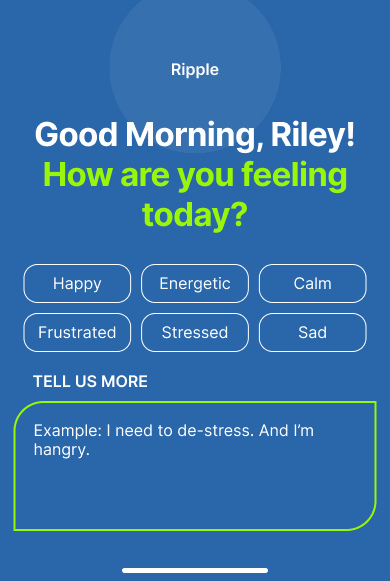Ripple Training.
Crafting an experience that is intuitive and engaging with end-to-end features to help people get 1% better every day in their health and fitness journeys.
-
UX/UI Design
-
4 Months
-
Figma
-
Solo
Overview.
-
Despite 70% of waking hours spent sitting, and 42% having fitness apps, only one-third of adults meet their weekly exercise goals.
-
Create lasting change by understanding habits, tailoring experiences to users' physical and mental goals, and starting a ripple effect of transformation, one step at a time.
-
In this 4-month UX Capstone Project, I researched and implemented features addressing user behaviors. I crafted frameworks and prototypes to communicate content strategy, design principles, and vision. I also designed and presented all work throughout the iterations of the product’s development.
Kickoff Distinction.
I emphasized a seamless user experience by following key design thinking stages:
Discover insights into the problem.
Define the area to focus upon.
Develop potential solutions.
Deliver solutions that work.
Discover
Discover
Research.
Did you know that experts suggest 150 minutes of moderate-intensity or 75 minutes of high-intensity cardio each week, along with two days of strength training? Research also revealed:
-
Fitness apps fell short when it came to personalizing and helping users reach both physical and mental goals.
-
Fitness apps lacked emphasis on enjoyable workouts and personalized goals. They tended to prioritize artificial goals and calorie counting over establishing proper nutrition and holistic motivation for overall well-being.
-
Music stood as the foremost enhancer during workouts, boosting physical performance, elevating mood, increasing endurance, aiding focus through distraction, and providing a motivational boost.
User-Centric Insights.
Gym enthusiasts hit the weights three times a week for 25-30 minutes, with music as the ultimate workout motivator.
While strength training was a favorite, navigating crowded equipment and choosing morning or evening workout times were the most challenging.
Fitness went beyond appearance—it was about enhancing mental and physical health.
-
Many were clueless about the best strategies for success.
-
Enthusiasm was absent, and motivation was usually at rock bottom.
-
Juggling numerous tasks daily left no time for self-care or exercise.
-
Loneliness was common from the lack of support needed to stay on track.
-
Pursuing fitness became a financial burden instead of a joy.
Pain Points.
Through user interviews and the analysis of my developed affinity map, I discovered key pain points:
FitOn
Nike
MyFitnessPal
Competitive Analysis.
I examined rival companies to improve design solutions and gain insights into users' experiences.
-
PROS: Celebrity workouts, ad-free experience, anytime fitness streaming, and a supportive community.
CONS: Primarily marketed towards women, and premium features including music, meal plans, and recipes come with additional costs.
-
PROS: Always free, workouts synced with music, highly motivating instructors, and algorithm-powered workout suggestions.
CONS: Limited long-term workout plans and no specific tracking feature for weight loss/gain/nutrition, making it less suitable for users with specific fitness goals.
-
PROS: Provides helpful breakdowns with charts and graphs, and recommends calorie targets based on weight goals.
CONS: Heavy focus on calorie counting without considering food choices, and neglects factors like body composition, genetics, and fitness levels when estimating calories, making it more like a guessing game.
Define
Define
How Might We?
After revisiting the problem, I came up with a HMW question:
How might we create a fitness journey that avoids burn-out, and encourages lasting changes in both physical and mental health?
Needs.
To gain a deeper understanding of users, I conducted interviews with 10 individuals and developed two personas.
These personas were essential for making user-centered decisions and ensuring a great user experience in my design process.
The core desires of users boiled down to:
A personalized blend of workouts and recipes.
Thoughtfully curated playlists.
Educational content on nutrition.
A supportive community.
Personalized programs.
No additional premium costs.
Solution Ideas.
Brainstorming expanded ideas to find the best possible solution for users.
-
Serving personalized mixes that seamlessly combine exercises, meals, and beats for daily motivation.
-
Auto-filling shopping lists with curated menus for users.
-
Uniquely tailored music mixes to match your exact needs, goals, and moods for each specific day.
-
Offering podcasts and meditation for a healthy user mind.
-
Diverse fitness experiences with classes in different styles—whiteboard, video, audio, and live.
-
Growing with the user and maximizing results with the power of progressive overload.
Develop
Develop
User Flow.
To improve the experience, I identified areas for improvement by connecting design solutions with user flow.
With my visual map as a compass, I created 2 red routes to tackle:
-
Objective: Learn users' goals, preferences, and info to create a personalized fitness plan.
Outcome: Give a tailored roadmap for ultimate success, with amazing gains and glory.
-
Objective: Combine music, meals, and workouts for exceptional onboarding results.
Outcome: Lead users through a smooth journey of sweat, beats, and satisfying gains.
Solution Sketches.
Through research, interviews, and brainstorming, I established the foundation for crafting solution sketches to enhance the onboarding journey.
My guiding principle was: “Lead with impact, trump with personalized content.”
I envisioned an onboarding journey focused on genuine connections, exploring users' goals like a trusted friend, sparking engagement, and instilling a sense of purpose for meaningful growth.
Initial Onboarding Challenge.
At first, enhancing the onboarding process was tough.
I had to carefully adjust questions, like solving a puzzle, to ensure that important ones were asked in the right sequence to truly understand the user.
The aim was to find the best order and flow to engage users from the start, providing an optimal onboarding experience.
Applying User Feedback.
"Subtract the obvious, add the meaningful" guided my approach during usability testing, helping me discover valuable feedback and make meaningful improvements:
From Dark to Light.
Through experimentation, I discovered that lightening the blue added a refreshing touch, and incorporating vibrant neon green created an electrifying contrast, setting the stage for a more captivating visual experience.
Valuable Feedback from Testing:
After interviewing 10 participants, the feedback was clear: "Well organized, but it needed a bit more personality."
Exploring motivations revealed a profound truth: fitness goals were just the tip of the iceberg. People were driven by something deeper. Empowered by this insight, I embarked on an onboarding journey focused on users, guided by empathy as my compass.
Onboarding Experience Evolution.
I incorporated empathy into the onboarding process, replacing the standard "select an option" with the more engaging "tell us more."
The realization struck when I understood that placing users at the forefront and recognizing them as the MVP (Most Valuable Persona) in my design, fostered meaningful connections and a deeper sense of belonging.
Second Round of Interviews.
Applying feedback, I redesigned screens and received positive feedback, with the standout quote being:
"I appreciated the personalized touch and how it seamlessly addressed my needs. It handled all the heavy lifting, allowing me to concentrate on what truly mattered."
Designing with Purpose.
After gathering valuable insights from the second round of interviews, I strategically prioritized these design principles:
-
Be personal. Learn and grow with the user over time.
-
Exist for both a functional and emotional purpose.
-
Rule personalization with intuitive defaults that respect the user's time and attention.
-
Make it about the experience.

Visual Process.
After establishing design principles as the brand's foundation, I crafted a mood board and style guide to bring it all to life.
The mood board influenced the style guide, reflecting motivation, energy, adaptability, efficiency, and personability. Blue conveyed sophistication and inspiration, and neon green added excitement and vitality. Simple circular graphics visually connected the brand name and image.
Style Guide.






The vision was simple: "Improve by 1% every day."
Deliver
Deliver
Introducing Ripple Training.
Your pocket-sized powerhouse – a personal trainer, foodie friend, and DJ rolled into one. Enjoy tailored workouts, recipes, and music to groove and improve. Dive deep into self-discovery, creating ripples of positive change that transform not just your body but also the world around you.
Onboarding: Turning the Process Personal.
Ripple's creative algorithm turns the app into a reliable workout buddy, fueled by users' true emotions. It maintains an empathetic connection, making it feel like chatting with a best friend rather than a virtual assistant.
The onboarding process dives into the depths of service and personalization, where 9 questions unlock the secret to understanding and growing with the user:
-
Understanding why users are on the app helps tailor the app to their specific goals.
-
Knowing preferred coaching style ensures a personalized and effective workout experience.
-
Identifying preferred exercises ensures the app suggests activities users will enjoy, keeping them motivated.
-
Learning about users favorite foods helps customize nutrition suggestions that fit users taste and health goals.
-
Gender helps provide workouts and advice that align with specific needs. Weight contributes to creating personalized workouts suitable for fitness levels and goals.
-
Knowing height and weight aids in tailoring exercises and measuring progress accurately.
-
Understanding favorite audio styles ensures an enjoyable and immersive workout experience.
Enhancing User Experience.
At the end of the onboarding journey, a single dynamic question prompts users to share their daily mood. This crucial input triggers the creative algorithm to curate an optimal mix of music, meal, and movement tailored to the user's specific mood and needs for the day, ensuring a path to success.
Spotlight Feature:
The Customized Mixer to Everyday Improvement.
Have the power to remix the perfect combination of workouts, meals, and music that aligns seamlessly with unique needs, all based on schedule, mood, and desires. Whether it's a high-intensity session to kickstart your day, a nutritious meal to fuel your body, or a motivating playlist to keep you in the zone, the user is in control.
Exercise and Music Feature:
Enhanced Journey through Variety and Insights.
Experience a tailored exercise journey with audio coaching, customizable music playlists, and three workout options: guided trainer-led videos, step-by-step instructions, or concise whiteboard lists. Track progress and achievements through a comprehensive summary for valuable fitness insights.
Meal Feature:
Effortless Meal Planning for a Healthy Diet.
Ripple app makes eating healthy easy. With meal planning, your weekly groceries are pre-selected and delivered, and preferences are always asked to customize meals.
Charity Feature:
Sweat for good: A completed workout will be donated to a charity of the users’ choice and keep users updated on local events that align with their interests.
“Working out is good for your body. Raising funds for charitable organizations is good for the world. Win-win.”
Community Feature:
Feedback Shapes the Journey.
Last but not least, with the supportive community features, your feedback constantly guides the next steps. Chat instantly, contact trainers, and access tips for the optimal goal journey. Support is always available.
Try the prototype below
Reflections.
Ripple Training was inspired by the idea that small changes bring significant impacts. It emerged from a perspective shift, acknowledging that true change begins from within. Success isn't merely hitting major milestones; it's the ongoing journey of self-improvement.
Facing challenges in this project taught me to step back, make small changes daily, and persist in fixing areas needing improvement—never giving up, always finding a solution.
“Outlook = Outcome”
Establishing a strong foundation for lasting success involved nurturing both the mind and soul and adapting how to approach challenges in all aspects of life.

























